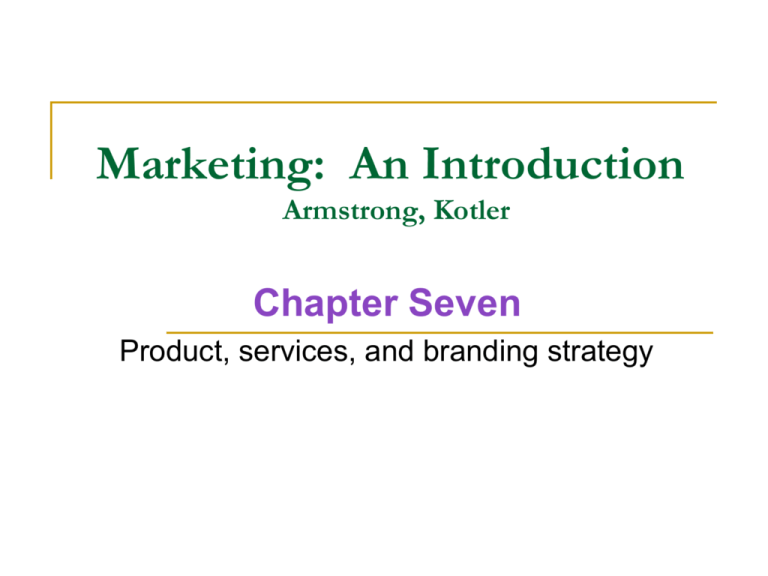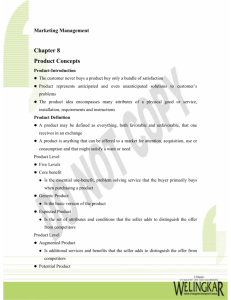KOTLER PDF
advertisement

Marketing: An Introduction Armstrong, Kotler Chapter Seven Product, services, and branding strategy Looking Ahead Define product and the major classifications of products and services. Describe the roles of product and service branding, packaging, labeling and product support services. Explain the decisions companies make when developing product lines and mixes. Identify the four characteristics that affect the marketing of a service. Discuss the additional marketing considerations that services require. Product Definition Product: any market offering that is intended to satisfy a want or need. Service: a type of product that is intangible and does not result in the ownership of anything. Experience: a type of product that combines a service or physical product with a memorable experience. Product Definition What is a Product ? Anything that can be offered to a market for attention, acquisition, use or consumption and that might satisfy a want or need. Includes: physical objects, services, events, persons, places, organizations, ideas or some combination thereof. Service Definition What is a Service ? A form of product that consists of activities, benefits or satisfactions offered for sale that are essentially intangible and do not result in the ownership of anything. Examples: banking, hotel, airline, retail, tax preparation, home repairs. Levels of product and services Figure 1 1- Core benefit; What is the buyer is really buying? Example: People buy camcorders to capture important moment. 2- Actual product; Features, brand name, quality, and packaging help the product to be delivered, like Features of the camcorder. 3- Augmented product; additional consumer services after sale. Warranty, delivery, credit, installation, service Levels of Product Figure 1 Products and Services Classifications; 1- consumer products; products and services bought by end users. Convenience, shopping, specialty, and unsought products ( Figure 2). 2- Industrial products; purchase for further processing or for use in conducting a business. Material, parts, capital items, and supplies and services. 3- Organizations, persons, places, and ideas; - Corporate image advertising - People; lawyers, doctors,,, market them-selves. - places; attract people to cities, region… - Ideas; crest “ create smiles everyday”. Social ideas to create social marketing to influence people Consumer products Convenience Products Shopping Products Buy frequently & immediately Buy less frequently Low priced Mass advertising Many purchase locations i.e Candy, newspapers Higher price Fewer purchase locations Comparison shop i.e Clothing, cars, appliances Specialty Products Unsought Products Special purchase efforts New innovations High price Unique characteristics Brand identification Few purchase locations i.e Lamborghini, Rolex Products consumers don’t want to think about Require much advertising & personal selling i.e Life insurance, blood donation Individual Product Decisions Product and Service decisions 1- Product attributes; Quality. Features. Performance and satisfaction includes level and consistency. Differentiates a product from the competition. Assessed based on value and cost. Style and design. Style equals appearance: Design is the heart of the product. 2- Branding Is a name, term, sign, symbol, design or combination of these that identifies the maker or seller of a product or service. Brand Equity Advantages to Branding Higher brand loyalty Buyers: Identification Name awareness Quality and value Perceived quality Sellers Strong brand Tells a story associations Provides legal Patents, trademarks, protection channel relationships Helps segments markets 3- Packaging: Developing a good wrapper for a product. Packaging concept. Package elements. Product safety. Environmental concerns. 4- Labeling: Identify the product Weights/measures Description/instructions Ingredients Nutritional information . 5- Product support services; Customer service Assess the value of current services and obtain ideas for new services. Assess the cost of providing the services. Put together a package of services that delights the customers and yields profits for the company. Product Line Decisions Product line: Group of closely related products due to function, similar target markets, outlets sold in, or similar pricing - Length: number of items in the product line. - Line stretching: adding items to either. Highend of the line can be stretched downwards. Marriott, Mercedes. - Line filling: adding items within the product line range. Increase sizes, Branding Strategy : Building strong Brands Brand equity: Positive differential effect that knowing the brand name has on customer response to the product or service. Brands are more than just names and symbols. Brands represent consumer’s perceptions and feelings about a product and its performance. Brands exits in the mind of consumers. Major Brand Strategy Decisions: Figure 3 Major Brand strategy decision Figure 3 Figure 10.3 Major Brand Strategy Decisions11- Brand positioning; Can position brands at any of three levels. Product attributes. Product benefits. Consumer beliefs and values. 2 - Brand name selection: Suggest something about the product’s benefits Easy to pronounce, recognize, and remember Distinctive and Extendable Ability to be translated into other languages Capable of being registered and legally protected Major Brand Strategy Decisions 3- Brand sponsorship: Manufacturer’s brand Brand sponsored and promoted by the producer of the good, such as Pepsi, IBM. Private brand Brand created and owned by a reseller of a product or service such as President’s Choice. Licensing 4- Brand development , Figure 4 Brand Development Strategies Figure 4 Service Marketing Service Characteristics Intangibility. Inseparability. Consumed when it is provided and cannot be separated from the provider. Variability. Cannot be seen, tasted, felt or smelled before purchasing. Quality depends on who provides. Perishability. Cannot be stored or resold. Figure 5 Nature and characteristics of service Figure 5 Marketing in Service Industries Service profit chain: 1- Internal service quality: selecting, hiring, training, talent employees leads to : 2- Satisfied employees: loyal productive, happy employees lead to: 3- Greater service value: High quality service delivery leads to: 4- Satisfied and loyal customers; loyal, repeat purchase leads to; 5- Business growth and profit: superior service performance. Internal Service quality Satisfied employees Service Value Satisfied customers Profit & growth Managing Service Differentiation Differentiate offer by: Innovative features Service delivery Images or symbols Service quality Service recovery: retain angry customers Service productivity - lowering the overhead costs - Increase service productivity Additional Product Considerations Product decisions and social responsibility Government regulation Food and product safety Pricing and advertising Labeling, weights, and measures Hazardous products Product liability International product and service marketing Standardization versus local adaptation Electrical standards, packaging Cultural differences in meaning Barriers to trade







